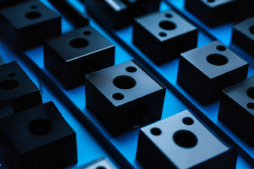ホワイトモリブデン素材の紹介
機械加工業界では、 ホワイトモリブデン加工 精度と革新の頂点を極めます。モリブデン素材の特性を理解することは、高性能アプリケーションでその潜在能力を最大限に引き出すために不可欠です。
特徴 ホワイトモリブデン
モリブデンホワイト材料の主な特性は、さまざまな産業および科学用途での有用性に貢献しています。それぞれの特性について詳しく見ていきましょう。
- 高反射率: モリブデンホワイト材料の高い反射率は、光の反射を最大限に高めることが重要な用途で有利です。たとえば、光の反射効率を高める光学コーティングや、鮮明でシャープな反射を生み出すミラーに使用できます。この特性は、光学、天文学、レーザー技術などの分野で価値があります。
- 高融点: モリブデンホワイト材料は融点が高いため、極端な温度を伴う用途に適しています。航空宇宙やエネルギーなどの業界では高温に遭遇することがよくありますが、モリブデンホワイト材料は大きな構造変化を起こさずにこれらの条件に耐えることができます。タービンブレード、ロケットノズル、炉部品などのコンポーネントに使用されます。
- 優れた熱伝導性: モリブデンホワイト材料の効率的な熱伝達能力は、熱管理アプリケーションで役立ちます。熱を効果的に放散し、安定した温度を維持できます。この特性は、過熱を防止したり熱安定性を維持するために効率的な熱放散が重要なヒートシンク、冷却システム、その他のアプリケーションで役立ちます。
- 耐腐食性: モリブデンホワイトは、特に酸性環境において優れた耐食性を発揮するため、腐食性物質や化学プロセスを扱う産業で重宝されています。硫酸や塩酸などの腐食性物質にさらされても耐えられるため、耐食性が不可欠な化学反応器、配管、その他の機器での使用に適しています。
- 低熱膨張: モリブデンホワイト材料は熱膨張係数が低いため、他の材料に比べて温度変化による膨張や収縮が少なくなります。この特性により寸法安定性が確保され、正確な寸法の維持が重要な用途で役立ちます。例としては、精密機器、光学システム、厳しい公差が求められる部品などがあります。
- 優れた電気伝導性: モリブデンホワイト材料は優れた電気伝導性を備えているため、電気を効率的に伝導します。この特性は、回路基板、電気接点、電極などの電気および電子アプリケーションで役立ちます。効率的な電流の流れを可能にし、さまざまな電子機器の信頼性の高いパフォーマンスをサポートします。
全体として、これらの特性の組み合わせにより、モリブデンホワイト材料は、光学、航空宇宙、エネルギー、熱管理、耐腐食性アプリケーション、精密工学、電子機器など、幅広い産業および科学分野で多用途かつ価値のあるものになります。

ホワイトモリブデンの用途
白モリブデンは、さまざまな業界で多種多様な用途に使用されています。注目すべき用途としては、次のようなものがあります。
- 航空宇宙および防衛白モリブデンは、耐熱性と強度に優れているため、航空機やミサイルのエンジン部品、ノズル、熱シールドなどの部品に使用されています。
- エレクトロニクスおよび半導体: 薄膜トランジスタ、LED、太陽電池などの電子機器や半導体の製造に使用されます。モリブデンは半導体産業にとって重要な材料です。
- 炉および高温用途白モリブデンは、高温炉、発熱体、その他極度の熱に対する耐性が求められる用途に使用されます。
- 医療機器モリブデン合金は生体適合性と耐腐食性があるため、医療機器やインプラントに使用されています。
- ガラス・セラミックス産業モリブデンは、ガラスおよびセラミック業界で、製造プロセス中のサポートと安定性を提供するために使用されています。
- 自動車産業モリブデンは、ピストンリング、バルブ、排気システムなど、耐熱性と耐久性が求められるさまざまな自動車用途に使用されています。
- 触媒モリブデン化合物は、石油精製やポリマーの製造など、さまざまな化学プロセスにおける触媒として使用されます。
これらは、ホワイトモリブデン材料の用途のほんの一例です。具体的な用途は業界によって異なり、アプリケーションの望ましい特性と要件によって異なります。
従来の材料よりもホワイトモリブデンを使用する利点
従来の材料よりも白モリブデンを選択すると、さまざまな業界に数多くの利点がもたらされます。主な利点は次のとおりです。
- 耐久性の向上白モリブデンは、その並外れた強度と剛性により長期にわたる耐久性が保証され、変形、摩耗、高温環境への耐性が求められる用途に最適です。
- 改善された熱管理: 優れた熱伝導性を持つ白モリブデンは、熱を効果的に放散し、部品やシステムの過熱のリスクを軽減します。この利点は、電子機器製造や発電など、温度制御が重要な産業にとって非常に重要です。
- 寿命の延長: ホワイトモリブデンは腐食や酸化に対して優れた耐性があるため、部品や装置の寿命が大幅に延び、メンテナンスコストが削減され、全体的な効率が向上します。カスタマイズ可能な加工: ホワイトモリブデンは複雑な形状に簡単に加工できるため、カスタマイズや精密なエンジニアリングが可能です。この汎用性により、機械や部品を特定の要件に合わせて調整でき、パフォーマンスと効率が向上します。
ホワイトモリブデンの将来の方向性と機会
技術の継続的な進歩により、白モリブデンの用途の可能性は拡大し続けています。有望な探査分野には次のようなものがあります。
- 先進製造業: 白モリブデンは耐久性、耐腐食性、高融点のため、積層造形(3D プリント)の有望な候補です。これは、従来の材料では必要な強度や耐熱性が得られない用途では特に当てはまります。
- 再生可能エネルギー: 白モリブデンは、その優れた電気伝導性と熱伝導性に加え、その堅牢性により、再生可能エネルギー技術にとって魅力的な選択肢となっています。効率性と耐久性が最も重要となる太陽電池、風力タービン、その他の再生可能エネルギーインフラでの使用が期待できます。
- 量子コンピューティング: ホワイトモリブデンのユニークな電気特性と低い熱膨張を考えると、急成長中の量子コンピューティング分野での潜在的な用途があるかもしれません。量子コンピューターは信じられないほど低い温度で動作する必要があるため、モリブデンの特性を備えた材料は量子コンピューターの開発にとって非常に重要になる可能性があります。
ホワイトモリブデンの課題と限界
白モリブデンには多くの利点がありますが、課題と限界を考慮することが重要です。
- 料金: モリブデンは比較的希少であるため、他の材料よりも高価になることがあります。また、モリブデンの抽出と加工には多大なエネルギー投入が必要であり、これもコストの増加につながります。
- 加工難易度: 白モリブデンは機械加工可能ですが、硬く融点が高いため、加工が難しい場合があります。特殊なツールと技術が必要になる場合があり、製造コストが増加する可能性があります。
- 低温での脆さ: モリブデンは高温では強度を保ちますが、低温では脆くなる可能性があります。そのため、低温が一般的な環境では、モリブデンの用途が制限される可能性があります。
現実世界 ケーススタディ ホワイトモリブデンの使用
- SpaceXのスターシップ: イーロン・マスク氏の野心的な宇宙探査プロジェクト、スペースXは、スターシップ宇宙船の建造にモリブデンの使用を検討していると報じられている。モリブデンは耐熱性に優れているため、ロケットのノズルや熱シールドなどの重要な部品に使用されている。
- 電子機器の熱管理: Apple や Samsung などの大手電子機器メーカーは、自社のデバイスの熱管理にモリブデンを使用する研究を行っています。モリブデンは熱伝導率が優れ、熱膨張係数が低いため、電子部品の過熱を防ぐのに最適です。
- CERNの大型ハドロン衝突型加速器: 世界最大かつ最強の粒子加速器である欧州原子核研究機構 (CERN) の大型ハドロン衝突型加速器 (LHC) では、優れた電気伝導性を持つモリブデンが使用されています。この特性により、衝突器の複雑な電磁石システム内での効率的なエネルギー伝達が促進されます。
モリブデンの環境と健康への影響を理解する
白モリブデンの特性は本質的に有益ですが、環境や健康への影響を考慮することが重要です。モリブデンとその化合物は、特に純粋な形では、一般的に人体や環境に対して無害です。ただし、三酸化モリブデンなどの特定の形態のモリブデンは、大量に吸入すると呼吸器系に危険を及ぼす可能性があります。したがって、潜在的なリスクを最小限に抑えるために、機械加工プロセス中は適切な安全対策を講じる必要があります。
ホワイトモリブデンが機械加工業界に革命を起こす可能性について議論
優れた特性と幅広い用途を考慮すると、白モリブデンは機械加工業界に革命を起こす大きな可能性を秘めています。強度、耐久性、熱伝導性、耐腐食性のユニークな組み合わせにより、白モリブデンは機械加工の可能性を再定義できる素材として位置付けられています。機械加工技術の継続的な研究と進歩により、白モリブデンは限界を押し広げ、さまざまな業界に革命を起こし続けるでしょう。
結論
こうした課題にもかかわらず、機械加工業界における白モリブデンの将来は明るいと見られています。そのユニークな特性により、幅広い用途に適しており、技術の継続的な進歩により、その潜在的な用途はますます増えています。
さらなる研究開発により、白モリブデンは材料加工の可能性を再定義し、さまざまな業界で新たな地平を切り開くことができるでしょう。
よくある質問
Q: 白モリブデンとは何ですか?
A: 白モリブデンは純モリブデン金属とも呼ばれ、すべての純金属の中で最も高い融点を持つ、柔らかい銀白色の材料です。航空宇宙工学や電子機器製造など、さまざまな分野で数多くの用途があります。
Q: 白モリブデンの主な特性は何ですか?
A: 白モリブデンの主な特性としては、高い反射率、高い融点、優れた熱伝導性、耐腐食性、低い熱膨張、優れた電気伝導性などが挙げられます。
Q: 白モリブデンの用途にはどのようなものがありますか?
A: 白モリブデンは、航空宇宙および防衛、電子機器および半導体、炉および高温用途、医療機器、ガラスおよびセラミック産業、自動車産業、化学プロセスの触媒など、さまざまな産業で使用されています。
Q: 白モリブデンの課題と限界は何ですか?
A: 課題としては、希少性によるコスト、硬度と高融点による加工の難しさ、低温での脆さなどが挙げられます。






